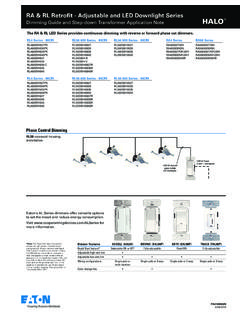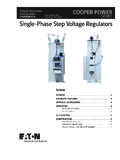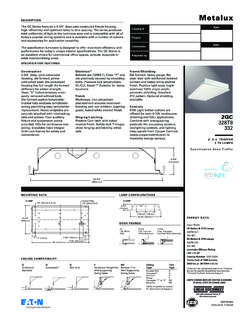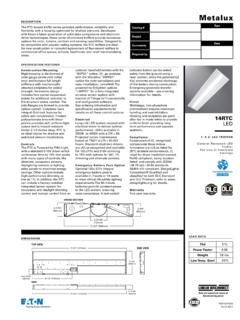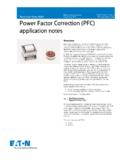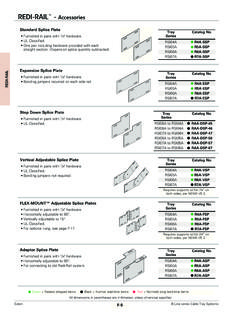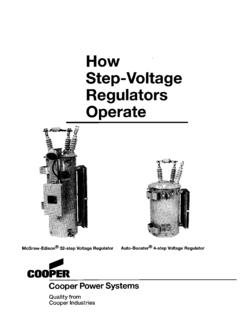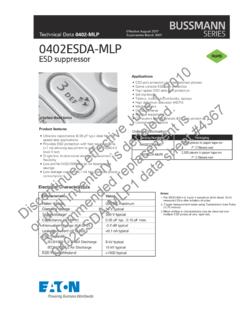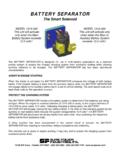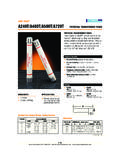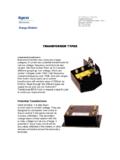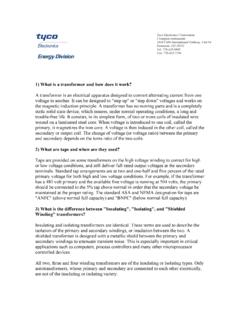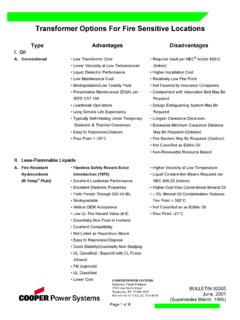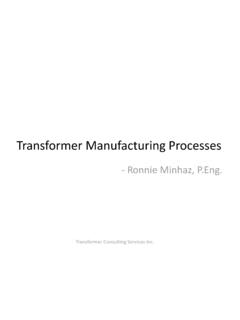Transcription of Equipment Protection - Cooper Industries
1 61 2005 Cooper BussmannTransformers 600V or LessEquipment ProtectionThe requirements of cover only transformer Protection . In practice, othercomponents must be considered in applying circuit overcurrent Protection . Forcircuits with transformers , requirements for conductor Protection per Articles240 and 310 and for panelboards per Article 408, must be observed. Refer (F), (B)(3), (C), (A) & (B).Primary Fuse Protection Only[ (B)] (See Figure below) If secondary fuseprotection is not provided (as discussed in the next Section) then the primaryfuses must not be sized larger than as shown transformer primary fuses are not necessary where the primary circuit fuse provides this must not be larger than 125% of transformer primary no transformer secondary Protection is provided(exceptions as noted above).
2 Primary600 Vor LessSecondary600 Vor LessTRANSFORMERNo SecondaryProtectionIndividual primary transformer fuse or primary feeder fusemust not be larger than 250% of primary full-load currentwhen secondary fuses are provided at 125%, exceptas noted LessSecondary600 VOr LessTRANSFORMERS econdary Fuses at 125%of secondary exceptas noted Fuse OnlyPrimary CurrentPrimary Fuse Rating9 amps or more125% or next higher standard rating if 125% does not correspond to a standard fuse amps to 9 amps167% maximumLess than 2 amps300% maximumPrimary and Secondary FusesSecondary Current Primary Fuse RatingSecondary Fuse Rating9 amps or more250% or next higher standard rating if 125% does not corre-spond to a standard fuse sizeLess than 9 amps250% : Section requirements pertain only to transformer Protection .
3 Additionalcircuit overcurrent Protection for conductors or panelboards may be required perArticles 240, 310, 408, * Primary Fuse (600V or less) and Secondary Fuse (600V or less). If secondary (600V or less) fuses are sized not greater than 125% of trans-former secondary current, individual transformer fuses are not required in theprimary (600V or less) provided the primary feeder fuses are not larger than250% of the transformer rated primary current. [See Note 3 of Table (B)for overcurrent Protection requirements of thermally protected transformers ].Note:Transformer overload Protection will be sacrificed by using overcurrentprotective devices sized much greater than the transformer The limits of150%, 167%, 250% and 300% may not adequately protect transformers .
4 It issuggested that for the highest degree of transformer overload Protection thefuse size should be within 125% of the transformer full-load magnetizing inrush currents for power transformers can range from 10times to 12 times the transformer full load current, for up to 6 cycles, and ashigh as 25 times transformer full load current at seconds. Some transformers may have inrush magnitudes substantially greater. Severe inrushshould be compared with melting times to assure that unnecessary opening ofthe device does not is a wide fuse amp rating range available to properly protect transformers .
5 Fusetron Class RK5 and Low-Peak Class RK1 dual-elementfuses can be sized on the transformer primary and/or secondary rated at125% of the transformer These dual-element fuses have sufficient time-delay to withstand the high magnetizing inrush currents of transformers . Thereis a wide amp rating selection in the 0 to 15A range for these dual-elementfuses to provide Protection for even small control required secondary Protection may be satisfied with multiple overcurrentdevices that protect feeders fed from the transformer secondary. The total amprating of these multiple devices may not exceed the allowed value of a singlesecondary overcurrent device.
6 If this method is chosen, dual-element, time-delay fuse Protection offers much greater flexibility. Note the following examples:Design 1 utilizes a single secondary overcurrent device. It provides thegreatest degree of selective coordination, transformer Protection , secondary cable Protection , and switchboard/ panelboard/load center Protection . The transformer cannot be overloaded to a significant degree if future loadsare added (improperly). With this arrangement the transformer s full capacity is 2005 Cooper BussmannTransformers 600V or LessEquipment ProtectionDesign 2 In this case the single secondary overcurrent device is eliminated, much of the Protection described in Design 1 willbe reduced.
7 If dual-element fuses are utilized as branch circuitprotection, the transformer can continue to be loaded with thefive 83A motors because 5 x 110 = 550A, (less than the maximum 600A). If additional loads are improperly added inthe future, overload Protection will be lost because the primarydevice can be sized at 250%.Design 3 If the single secondary overcurrent device is eliminated andMCPs are utilized as branch circuit Protection , the transformerwill be seriously under-utilized because only one motor can beconnected. For one motor, 1 x 700% of 83 = 581 amps. Fortwo motors, 2 x 700% of 83 = 1162 amps.
8 Since the sum ofthe devices cannot exceed 600 amps, only one motor can beconnected when the motor circuit is protected by an 4 Using the same procedure, if the single secondary main iseliminated and thermal magnetic circuit breakers are utilizedas branch circuit Protection per , only three of themotors can be connected because the thermal magneticbreakers will have been sized at approximately 250% of themotor (83 x 250% = )Note:If sized less than permitted by , nuisance tripping may resultsince the new energy efficient motors have higher inrush a 200A circuit breaker would allow only three (600 200) motors to beconnected.
9 To add two additional motors of the same type as shown in Design1 and Design 2 requires a larger transformer - one that would have a 1000A ormore secondary capability. A 300kVA 208V transformer has a 830A secondaryrating which is not sufficient. Therefore, the next standard size 3 transformeris a 400kVA with a 1110A capacity to meet the new 2005 Cooper BussmannTransformers Over 600 VEquipment ProtectionPrimary and Secondary ProtectionIn unsupervised locations, with primary over 600V, the primary fuse can besized at a maximum of 300%. If the secondary is also over600V, the secondary fuses can be sized at a maximum of 250% for transformers withimpedances not greater than 6% or 225% for transformers with impedancesgreater than 6% and not more than 10%.
10 If the secondary is 600V or below,the secondary fuses can be sized at a maximum of 125%. Where these ratings do not correspond to a standard fuse size, the next higher standardsize is Z 6% Max Fuse= 250%Over600 VOver600 VMax Fuse= 300%Max Fuse= 225%Over600 VOver600 VMax Fuse= 300%Max Fuse= 125%600V or BelowOver600 VMax Fuse= 300%PRIMARYSECONDARY6% < Z 10% UnsupervisedLocationsOver600 VMax Fuse= 300%PRIMARYSECONDARY600V600V600V600V600V orBelowOverOverOverOverMax Fuse= 300%Max Fuse= 300%Max Fuse= 225%Max Fuse= 250%Max Fuse= 250%SupervisedLocations% Z 6%6% < Z 10%In supervised locations, the maximum ratings are as shown in the next diagram.
